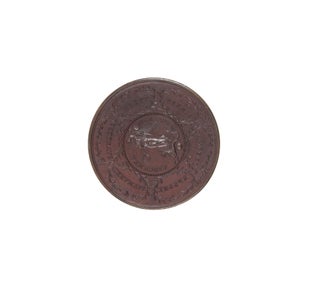Copper Medal for the 1740-1744 Circumnavigation…
Copper Medal in commemoration of his 1740-1744 Circumnavigation and 1747 defeat of the French at Cap Finisterre.
London: Thomas Pingo, 1747.
Copper medal, 43.3 mm., with Anson crowned by Victory at right, on the reverse Victory on hippocamp, the names of Anson's officers around; CAMPHEL issue with 'B' faintly visible on 'H', about uncirculated, a few minor blemishes to the rims.
Circumnavigation and victory
An excellent medal, commemorating Anson's circumnavigation and his 1747 victory at Cap Finisterre off the coast of Spain. The huge prize-money brought back after the capture of the Manila treasure galleon, followed by the magnificent defeat of the French navy, were achievements which spoke enormously to popular feeling.
An excellent medal, commemorating Anson's circumnavigation and his 1747 victory at Cap Finisterre off the coast of Spain. The huge prize-money brought back after the capture of the Manila treasure galleon, followed by the magnificent defeat of the French navy, were achievements which spoke enormously to popular feeling.
This medal, to commemorate Anson's great successes, was commissioned from Thomas Pingo (1692-1776), then assistant engraver at the Royal Mint. On the obverse is a bust of the admiral crowned with a laurel by Victory and the caption 'Vict. Mai III MDCCXLVII'. The reverse bears the legend 'Circumnavigation' and the names of other officers on the famous journey, themselves famous names in the British navy: Keppel, Saumarez, Saunders, Brett, Dennis, and Campbel.
When the medal was originally issued the name of the junior officer Campbel was mis-engraved "Camphel". The present medal is an example of the interim state of the medal, with the 'H' altered to a 'B', but not completely effaced. Eimer suggests that the medal was commissioned by Thomas Anson, George's brother and himself a collector of medals. In this light, it has plausibly been argued that the long-accepted date of production of 1747 is in fact far too early, and that it was not until 1768, six years after Anson's death, that this medal was commissioned and struck.
George Anson was one of the most successful British naval commanders of the eighteenth-century, famous for his notoriously difficult circumnavigation of the globe from 1740-1744 as commander of the Centurion. In 1739 he had been given command of a Pacific squadron to raid Spanish possessions, a period at sea which saw him lose five of his six ships and literally most of his crew, but also return with a staggering £400,000 in bounty after his capture of the Manila treasure galleon. 'After the fleet's failure off Toulon in February the navy stood in need of a popular triumph, and the capture of a treasure galleon was in the public mind the next best thing to a fleet victory. Day after day the newspapers carried reports of the homecoming: the procession from Portsmouth to London, with thirty-two wagons laden with treasure; the feting of Anson and his men; details of the prize money and the dispute over its allocation…' (Williams, p. 229). Anson went on to a long career and, as this medal also commemorates, was instrumental in the French defeat at Finisterre off the Spanish coast on 3 May 1747, where his thirteen ships of the line defeated the French admiral De la Jonquiere's smaller fleet in just three hours with most of the French men-of-war taken.
Betts, American Colonial History Illustrated by Contemporary Medals, 382; Eimer, British Commemorative Medals, 38; Hawkins and Grueber, Medallic Illustrations of British History, 325.
Price (AUD): $3,450.00
US$2,223.85 Other currencies



